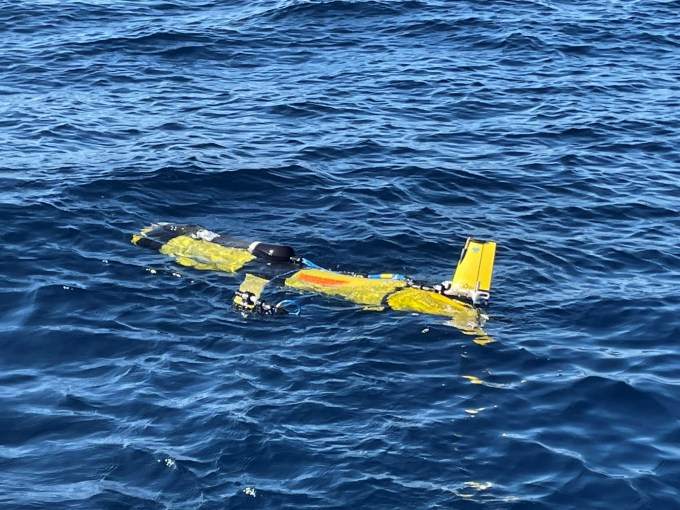In September, Teledyne Marine deployed multiple Unmanned Underwater Vehicles (UUVs) during REPMUS 23 experimentation and DYNAMIC MESSENGER 23 exercise which took place in Troia and Sesimbra, Portugal. REPMUS (Robotic Experimentation and Prototyping with Maritime Unmanned System) REPMUS is the largest unmanned system experimentation exercise, with participation broadly across NATO nations. REPMUS is a great opportunity to experiment with new capabilities and test the interoperability between unmanned systems. Teledyne Marine deployed its newly developed Osprey Autonomous Underwater Vehicle? (AUV), from the Portuguese Navy NPR Dom Carlos I in support of a Critical Undersea Infrastructure (CUI) protection experiment as part of the broader Undersea Warfare experiments. Osprey is a 2000 meter rated modular, 324 mm diameter AUV and was fitted with an EdgeTech 2205 Side Scan Sonar with bathymetry and gapfill option during REPMUS 23. Using its interferometric sonar Osprey was cable to generated high resolution images of a 18 mm diameter cable and identify the emplacement of multiple inert explosive ordnance devices via change detection from the side scan sonar images.
“REPMUS 23 was a significant commitment by Teledyne Marine and provided a unique opportunity to experiment with our latest innovations not only in sensors and vehicles but in timely operational scenarios. We would like to thank NATO, The United Kingdom Royal Navy, The Royal Danish Navy, The Portuguese Navy, The GEOMETOC COE and the different syndicates for the privilege to participate and the collaboration offered to Teledyne. We supported REPMUS 23 with new capabilities that have a high technology readiness level and are ready to be deployed by NATO and our other military customers. We continue to persevere to support NATO with innovative technology and solution to address the emerging threat to Critical Undersea Infrastructure” says Thomas W. Altshuler, Ph.D., Senior Vice President, Global Maritime Defense Strategy and Business Development, Teledyne Technologies.

Teledyne Marine also contributed its T20-S Multibeam Module?, a new payload now available for Teledyne’s 200 mm diameter, 1000 meter rated commercial Gavia AUV. Leveraging the true modular design of the Gavia AUV?, the T20-S Module was fitted to the Royal Danish Navy Gavia system and operated during the Distressed Submarine (DISSUB) experiment. A Portuguese Navy submarine simulated a major failure by bottoming at approximately 100 meters depth. The GAVIA AUV was used to survey the orientation of the submarine on the bottom to facilitate rescue operations. The T20-S Module features a 400kHz Multibeam with 1° by 1° beam angle, 1024 beams, and maximum pulse rate of 50Hz, offering high resolution images in .s7k data format. The data was processed in Teledyne PDS? and Teledyne Caris software. The T20-S Module was also fitted to one of the Polish Navy Gavia AUV to illustrate the true interoperability in between Nations and assets. The Polish Navy operated the T20-S Module as part of the Naval Mine Warfare portion of REPMUS to achieve mine like objects classification using backscatter and bathymetric data.
Teledyne Marine contributed additional unmanned systems to REPMUS 23 including an APEX-EM Profiling Float which was fitted with conductivity, temperature, and depth (CTD) and Electro-Magnetic sensors and a Slocum glider with CTD and a JASCO Applied Sciences OceanObserver Snout with four hydrophones. The APEX-EM measures water motion through induced electromagnetic currents during profiling. The data collected during REPMUS was fed to the Rapid Environmental Assessment (REA) team and the NATO GEOMETOC Center of Excellence (COE) in Portugal. The APEX-EM float was air deployed by the Schiebel S-100 Vertical Takeoff and Landing (VTOL) Unmanned Air System (UAS) demonstrating a new rapid deployment method directly to the mission area. Teledyne Marine deployed an acoustic G3 Slocum Glider to support the REA effort and the NATO GEOMETOC COE with valuable oceanographic water column data. The Slocum glider was equipped with a JASCO Applied Sciences OceanObserver with a spatial acoustic array allowing ambient noise recording and directional detection of any identifiable target.

Teledyne Marine is a group of leading-edge subsea technology companies that are part of Teledyne Technologies Incorporated. Through acquisitions and collaboration over the past ten years, Teledyne Marine has evolved into an industry powerhouse, bringing Imaging, Instruments, Interconnect, Seismic, and Vehicle technology together to provide total solutions to our customers. Each Teledyne Marine company is a leader in its respective field, with a shared commitment to providing premium products backed by unparalleled service and support.











